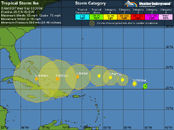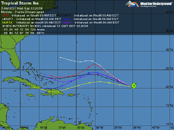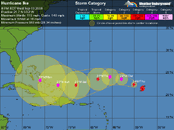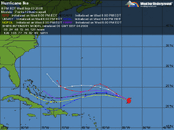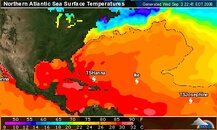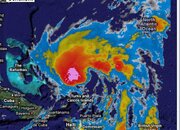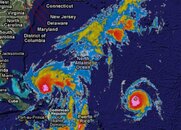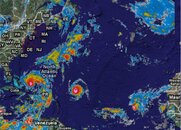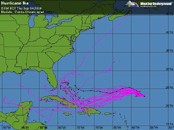Ike
Tropical Storm Ike continues getting organized over the middle Atlantic, and has the potential to become a large and dangerous Cape Verdes-type hurricane by Monday, when it is expected to be in the southeastern Bahama Islands. Visible satellite loops show that heavy thunderstorm activity is starting to wrap around the core of the storm, and Ike has about 50% of an eyewall built. Upper-level outflow is good, and Ike is in a very favorable upper-level wind environment, with an upper-level anticyclone overhead, and wind shear less than 10 knots. Ike has moistened the atmosphere around it enough to wall off a large amount of dry air that surrounds it. Rather cool sea surface temperatures (SSTs) of 27.5°C. SSTs will quickly warm to 29°C over the next two days, but the shear is forecast to increase to 20-35 knots Thursday through Friday. The SHIPS model responds by strengthening Ike only to a Category 1 hurricane today, then weakening it to a tropical storm during the higher shear, then strengthening it again to a Category 1 hurricane by Saturday. The HWRF and GFDL models do not predict the shear will affect Ike as much Thursday and Friday, and intensify the storm into a Category 2 or higher hurricane by Sunday. The HWRF makes Ike a Category 4 hurricane in the eastern Bahama Islands on Monday, and the GFDL has Ike hitting eastern Cuba as a Category 2 or 3 hurricane on Monday. I expect Ike to be a hurricane by Thursday morning, and a Category 3 or higher hurricane by Monday.
The longer term fate of Ike is highly uncertain. The ECMWF and GFS models both forecast that Hanna will be strong enough to create a weakness in the ridge of high pressure steering Ike to the west. Ike will then follow Hanna's path, recurving northwards. the timing of this recurvature is critical, as the GFS shows that Ike will miss the U.S., while the ECMWF forecasts a strike in South Florida on Tuesday, then another landfall in North Carolina later in the week. If Hanna is not as strong or is faster-moving than these models expect, Ike may not recurve. Instead, Ike will cross Cuba or move through the Florida Straits, eventually emerging into the Gulf of Mexico to cause havoc there.





